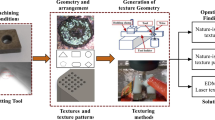Abstract
Effectively improving the precision and surface quality simultaneously is the goal of manufacturing technology. Due to the excellent surface quality of machined workpieces, electrochemical mechanical machining (ECMM) has been widely used as a polishing method for different components. Recent studies have found that ECMM can not only reduce surface roughness, but also improve precision to some extent. Under precision machining conditions, the roughness error value is close to the precision error value; therefore, leveling the roughness can improve the precision. To explore whether correcting the contour error of a rotary surface is caused by roughness improvement or the fundamental changes of its profile, orthogonal experiments were carried out to verify that electrochemical parameters had more influence on the precision than mechanical parameters. The machining current was the most important factor for accuracy. On this basis, an experiment was carried out under changing cathode coverage, and the results showed that component precision was affected by the cathode coverage on the workpiece surface. Specifically, the contour macro morphology exhibited a remarkable change with increasing cathode coverage, and this change was independent of roughness. This result demonstrated that under the same mechanical and electrochemical parameters, the contour error, which can be attributed to error homogenization, could be corrected by enlarging the influence area of the cathode on the workpiece surface. Therefore, ECMM can not only polish the part surfaces, but also fundamentally improve machining accuracy, showing promising application prospects in the trans-scale precision shaping of high-precision components.





Similar content being viewed by others
References
Zhang Z (2008) General mechanical design manual. Machinery Industry Press, Beijing
Raparelli T, Viktorov V, Colombo F, Lentini L (2016) Aerostatic thrust bearings active compensation: critical review. Precis Eng 44:1–12
Wang JY, Xu JW (2001) The principle and application of electrochemical machining. National Defense Industry Press, Beijing
Zhang ZJ, Zhang MQ, Cao XP (2012) Research status of electrochemical mechanical composite finishing technology. Mater Rev 26(13):12–15
Zhang M, Hou Y, Mao S (2003) Experimental research on the surface profile machined with electrochemical mechanical finishing. Chin J Mech Eng 39(7):154–158
Lee SJ, Lee YM, Du MF (2003) The polishing mechanism of electrochemical mechanical polishing technology. J Mater Process Technol 140(1-3):280–286
Pang GB, Zhai XB, Xu WJ, Zhou JJ (2009) Electrochemical mechanical finishing technique for mould cavity surface. Mold Ind 35(3):55–59
Jang KI, Seok J, Min BK, Lee SJ (2010) An electrochemomechanical polishing process using magnetorheological fluid. Int J Mach Tool Manu 50(10):869–881
Joo S, Liang H (2012) Triboelectrochemical characterization of copper surface. Microelectron Eng 98(10):12–18
Joo S, Liang H (2013) In situ characterization of triboelectrochemical effectson topography of patterned copper surfaces. J Electron Mater 42(6):979–987
Rao PS, Jain PK, Dwivedi DK (2015) Electro chemical honing of external cylindrical surfaces of titanium alloys. Procedia Engineering 100:936–945
Zhou JJ, Wang XM (2002) Characteristic of electrochemistry machining bearing raceway surfaces. Bearing 9:15–17
Brown AS (2005) Flat, cheap, and under control [electrochemical mechanical planarization]. IEEE Spectr 42(1):40–45
Zhang KH, Shi D, Liu RZ (2016) Electrochemical mechanical composite polishing thin film solar cell flexible stainless steel substrate. Opt Precis Eng 24(2):343–349
Pathak S, Jain NK (2017) Modeling and experimental validation of volumetric material removal rate and surface roughness depth of straight bevel gears in pulsed-ECH process. Int J Mech Sci 124-125:132–144
Kurita T, Endo C, Matsui Y, Masuda H, Terasawa K, Tanaka F, Hiromichi I, Oguchi K, Kobayashi K (2008) Mechanical/electrochemical complex machining method for efficient, accurate, and environmentally benign process. Int J Mach Tool Manu 48(15):1599–1604
Pang GB, Aday X, Xu WJ, Zhou JJ (2011) Surface quality and accuracy characteristics of cylindrical gears by generative electrochemical-mechanical finishing. Aust J Mech Eng 47(19):163–167
Xu WJ, Wei ZF, Sun J, Wei L, Yu ZY (2012) Surface quality prediction and processing parameter determination in electrochemical mechanical polishing of bearing rollers. Int J Adv Manuf Technol 63(1-4):129–136
Shaikh JH, Jain NK (2015) Effect of finishing time and electrolyte composition on geometric accuracy and surface finish of straight bevel gears in ECH process. CIRP J Manuf Sci Technol 8:53–62
Shaikh JH, Jain NK (2016) Investigations on micro-geometry improvement of straight bevel gears finished by electrochemical honing process. Int J Adv Manuf Technol 85(9-12):2223–2234
Pang GB, Xin KK, Xu WP (2018) Surface topography and accuracy characteristics of electrochemical abrasive belt finishing of rotational groove. Surf Technol 47(7):73–82
Han LH, Jia YC, Cao YZ, Hu ZJ, Zhao XS, Guo SS, Yan YD, Tian ZQ, Zhan DP (2018) The coupling effect of slow-rate mechanical motion on the confined etching process in electrochemical mechanical micromachining. China Chem 61(6):1–10
Funding
This research was financially supported by the National Science Foundation of China (51675072) and the LiaoNing Revitalization Talents Program (XLYC1802093).
Author information
Authors and Affiliations
Corresponding authors
Additional information
Publisher’s note
Springer Nature remains neutral with regard to jurisdictional claims in published maps and institutional affiliations.
Appendix A change in contour shape with different cathode coverage
Appendix A change in contour shape with different cathode coverage
(a) Change in contour shape with a cathode coverage of 27°

(b) Change in contour shape with a cathode coverage of 90°

(c) Change in contour shape with a cathode coverage of 120°

Rights and permissions
About this article
Cite this article
Pang, G., Chen, W., Fan, S. et al. Experimental study on correcting the contour error of a rotary surface machined by electrochemical mechanical machining. Int J Adv Manuf Technol 104, 2827–2838 (2019). https://doi.org/10.1007/s00170-019-04135-w
Received:
Accepted:
Published:
Issue Date:
DOI: https://doi.org/10.1007/s00170-019-04135-w




